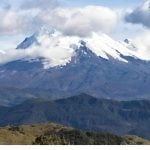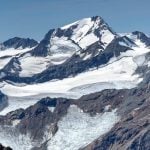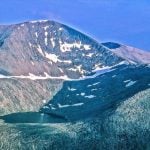The Rocky Mountains: The Backbone of North America
The Rocky Mountains, a majestic mountain range stretching over 4,800 kilometers (3,000 miles) in length and reaching up to 1,600 kilometers (1,000 miles) in width, form the western edge of the North American continent. Starting from the Canadian provinces of British Columbia and Yukon, and extending all the way down to the border of the US state of New Mexico, these mountains hold immense significance in the continent’s geological and geographical history. The Rocky Mountains: The Backbone of North America :
Geological Formation
The Rocky Mountains were formed about 50 to 80 million years ago due to the collision of the Pacific and North American plates. This collision cracked and uplifted the continent’s crust, and over millions of years, it was shaped by geological processes like erosion and glaciation. Today, home to numerous peaks exceeding 4,300 meters (14,000 feet), the Rocky Mountains stand as one of the continent’s highest regions.
Geographical Features
The Rocky Mountains harbor a diverse ecosystem with a variety of flora and fauna. Rugged terrains, lush forests, glaciers, lakes, and rivers form important parts of this ecosystem. The region is home to numerous national parks and protected areas, safeguarding its natural beauty.
Climate
The climate of the Rocky Mountains varies depending on altitude and location. Generally, a continental climate prevails in the region. Winters are cold and snowy, while summers are cool and wet. Higher elevations may experience snowfall throughout the year.
Natural Resources
The Rocky Mountains possess significant natural resources, including oil, natural gas, minerals, and forest products. These resources play a vital role in the regional economy.
Tourism
The Rocky Mountains are a popular destination for tourists due to their natural beauty and diverse recreational opportunities. The region offers a wide range of outdoor activities, including hiking, camping, skiing, fishing, canoeing, and rafting. National parks and protected areas provide visitors with an immersive experience in nature.
Rocky Mountains FAQ
What are the Rocky Mountains?
The Rocky Mountains are a majestic mountain range stretching over 4,800 kilometers (3,000 miles) in length and reaching up to 1,600 kilometers (1,000 miles) in width, forming the western edge of the North American continent. Starting from the Canadian provinces of British Columbia and Yukon, and extending all the way down to the border of the US state of New Mexico, these mountains hold immense significance in the continent’s geological and geographical history.
When were the Rocky Mountains formed?
The Rocky Mountains were formed about 50 to 80 million years ago due to the collision of the Pacific and North American plates. This collision cracked and uplifted the continent’s crust, and over millions of years, it was shaped by geological processes like erosion and glaciation.
What is the highest mountain in the Rocky Mountains?
The highest mountain in the Rocky Mountains is Mount Robson, located in Canada, with an elevation of 4,399 meters (14,433 feet).
Which states and provinces are in the Rocky Mountains?
The Rocky Mountains run through the Canadian provinces of British Columbia and Alberta, and the US states of Montana, Idaho, Wyoming, Colorado, Utah, and New Mexico.
What national parks are in the Rocky Mountains?
The Rocky Mountains are home to numerous national parks. Some notable examples include:
-
Banff National Park (Canada)

Nestled in the Canadian province of Alberta, Banff National Park stands as the country’s first national park, established in 1885. Encompassing a vast 6,641 square kilometers, the park is a haven for nature enthusiasts, captivating visitors with its breathtaking mountain vistas, turquoise lakes, glaciers, and lush forests.
The park offers a diverse range of activities to suit all tastes. Embark on exhilarating hikes, set up camp amidst serene surroundings, paddle canoes across tranquil waters, cast a line for fresh catches, or glide down snow-covered slopes. Ascend Sulphur Mountain via the Banff Gondola for panoramic views, or embark on a scenic boat tour of Moraine Lake. The park is also home to an abundance of wildlife, including elk, grizzly bears, wolves, and foxes.
While Banff National Park is a year-round destination, summer beckons with its warmer temperatures and sunny skies. Winter transforms the park into a wonderland for skiing and snowboarding enthusiasts.
Planning ahead is essential for those considering a visit to Banff National Park. Accommodation options range from campgrounds to hotels and lodges. The park is approximately a 1.5-hour drive from the city of Calgary.
Banff National Park beckons adventurers and nature lovers, promising an unforgettable experience amidst its breathtaking landscapes.
-
Jasper National Park (Canada)
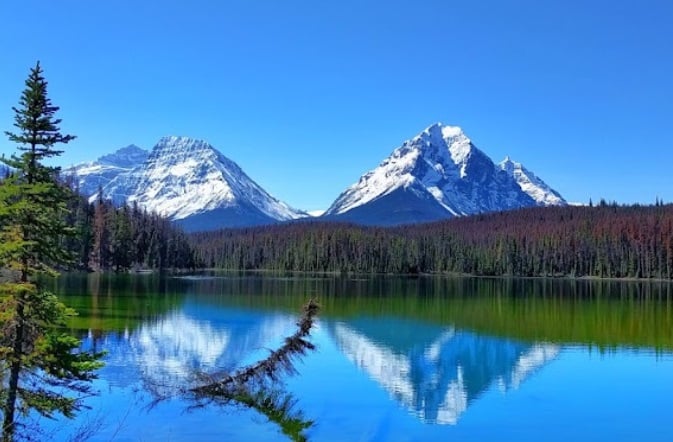
Nestled in the Canadian province of Alberta, Jasper National Park stands as the nation’s second-oldest national park, established in 1930. Spanning an expansive 10,878 square kilometers, the park lies north of Banff National Park and resides within the heart of the Canadian Rocky Mountains, a UNESCO World Heritage Site.
Jasper National Park beckons adventurers seeking an intimate encounter with untamed wilderness. The park harbors an abundance of wildlife, including grizzly bears, wolves, elk, foxes, and eagles. Embark on invigorating hikes, pitch your tent amidst serene landscapes, paddle canoes across tranquil waters, cast a line for fresh catches, or conquer the rapids on exhilarating rafting adventures. In Jasper National Park, you can embark on a scenic boat tour of Jasper Lake, explore the depths of Maligne Canyon, or marvel at the breathtaking spectacle of Athabasca Falls.
Planning a visit to Jasper National Park?
Anticipate your adventure by carefully arranging your accommodation and transportation. The park offers a diverse range of lodging options, from campgrounds to hotels and lodges. Jasper National Park is approximately a 3-hour drive from Edmonton and a 4-hour drive from Calgary.
Unveiling the Treasures of Jasper National Park:
-
Hiking: Embark on invigorating hikes along trails tailored to all skill levels.
-
Camping: Immerse yourself in nature’s embrace by pitching your tent at one of the park’s many designated campgrounds.
-
Canoeing: Glide across the tranquil waters of Jasper Lake or Maligne Lake on a serene canoeing adventure.
-
Fishing: Cast your line and test your angling skills in the park’s abundant lakes and rivers.
-
Rafting: Conquer the thrilling rapids of the Athabasca River on an exhilarating rafting excursion.
-
Boat Tours: Embark on a scenic boat tour of Jasper Lake, soaking in the splendor of the surrounding landscapes.
-
Maligne Canyon: Delve into the depths of Maligne Canyon, exploring its awe-inspiring rock formations and hidden waterfalls.
-
Athabasca Falls: Marvel at the breathtaking spectacle of Athabasca Falls, a cascading masterpiece of nature.
Before Your Jasper National Park Adventure:
-
Check the weather forecast and pack accordingly.
-
Ensure you have essential supplies like insect repellent and sunscreen.
-
Bring ample water and food provisions.
-
Familiarize yourself with park regulations and guidelines.
-
Exercise caution in bear and wildlife encounters.
Jasper National Park is a treasure trove of natural wonders, offering an unforgettable experience for nature enthusiasts. By carefully planning your visit and adhering to park regulations, you are well on your way to an extraordinary adventure amidst the park’s captivating landscapes.
-
Yoho National Park (Canada)
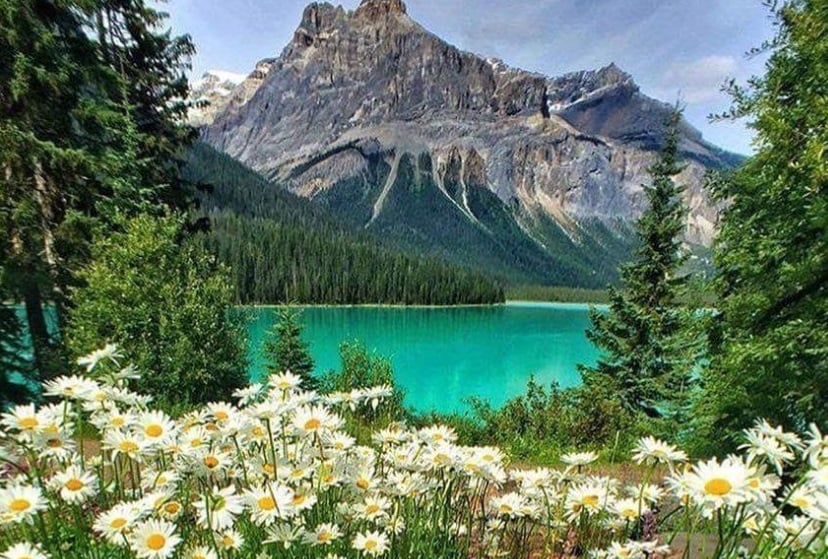
Nestled in the heart of the Canadian Rockies in British Columbia, Yoho National Park is a breathtaking haven of natural wonders. Established in 1886, the park encompasses 1,313 square kilometers (507 sq mi) and is home to iconic landmarks like Emerald Lake, Takakkaw Falls, and the Natural Bridge.
Soaring mountain peaks, glacier-fed lakes, cascading waterfalls, and lush forests abound within the park’s boundaries. The Kicking Horse River meanders through the park, nourishing Canada’s third-highest waterfall, Takakkaw Falls. Offering a haven for outdoor enthusiasts, Yoho National Park is a paradise for hiking, camping, fishing, and canoeing. The park also boasts a rich history and cultural heritage, with exhibits showcasing the traditions of the Ktunaxa people who once inhabited the area, providing visitors with an unforgettable cultural immersion.
-
Kootenay National Park (Canada)
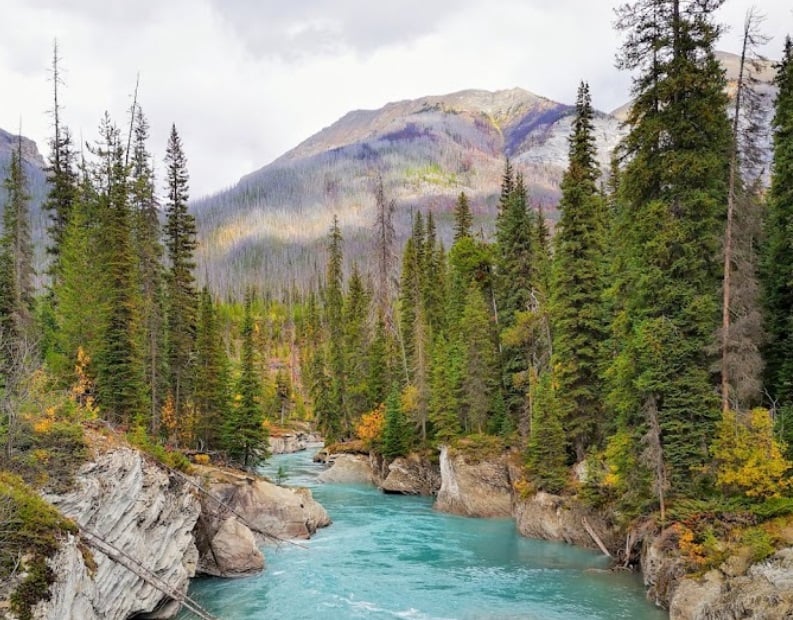
Kootenay National Park is a national park in the Canadian province of British Columbia. Established in 1920, it encompasses 1,406 square kilometres (543 sq mi) of the Kootenay and Park Ranges of the Rocky Mountains, as well as the Kootenay and Vermilion Rivers.
The park is home to a diverse range of natural beauty, including lush forests, pristine lakes, snow-capped peaks, and cascading waterfalls. Visitors can enjoy a variety of outdoor activities in the park, such as hiking, camping, fishing, canoeing, and rock climbing. The area is also rich in history and culture, and is the traditional territory of the Ktunaxa people.
Kootenay National Park is part of the Canadian Rocky Mountain Parks UNESCO World Heritage Site, and is also home to some of the world’s most important geological sites, such as the Burgess Shale fossils. These ancient fossils are over 500 million years old and provide a unique window into the early history of life on Earth.
Kootenay National Park offers an unforgettable experience for anyone who appreciates the beauty of nature and the importance of history. The park is open year-round and offers something different for every season.
Here are some additional details about Kootenay National Park:
- Location: British Columbia, Canada
- Size: 1,406 square kilometres (543 sq mi)
- Established: 1920
- Notable features: Kootenay and Park Ranges of the Rocky Mountains, Kootenay and Vermilion Rivers, Burgess Shale fossils
- Activities: Hiking, camping, fishing, canoeing, rock climbing
- UNESCO World Heritage Site: Yes
-
Glacier National Park (USA)
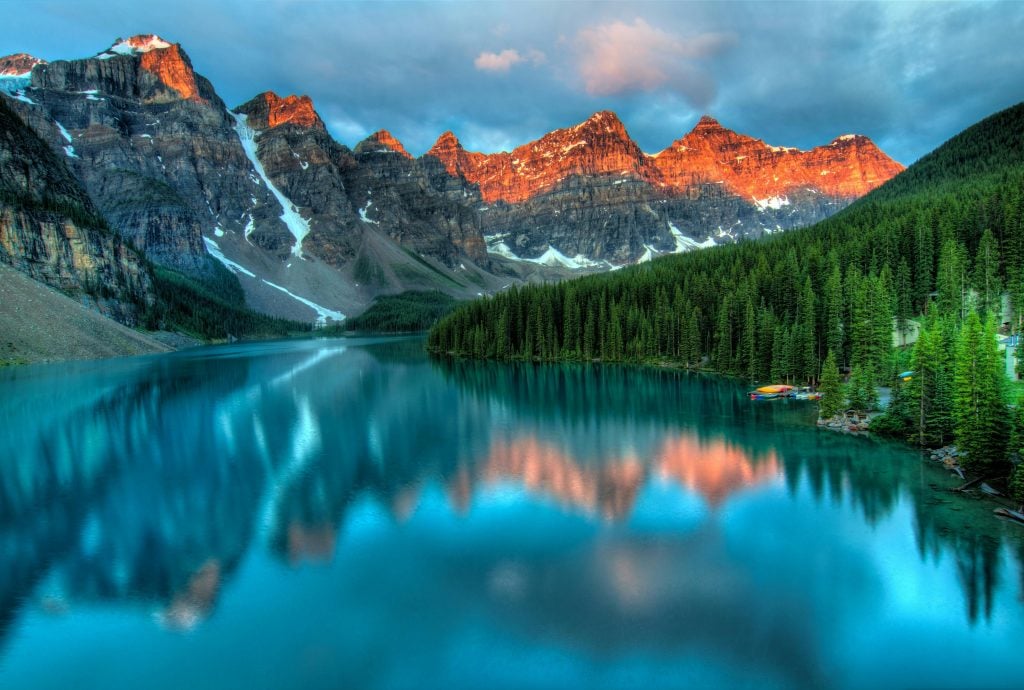
Nestled in the northwestern corner of the state of Montana, Glacier National Park is a natural wonderland encompassing a vast 4,101 square kilometers (1,583 sq mi) of breathtaking scenery and an abundance of wildlife. Established in 1910, the park is considered one of the most picturesque corners of the Rocky Mountains, drawing millions of visitors each year.
One of the park’s most striking features is its diverse geological formations, including glacier-carved valleys, pristine lakes, and cascading waterfalls. The awe-inspiring Going-to-the-Sun Road winds through the heart of the park, offering visitors panoramic vistas of the mountains. The park also boasts a rich tapestry of flora and fauna, including over 1,100 plant species and more than 70 mammal species.
Visitors can enjoy a variety of outdoor activities in Glacier National Park, such as hiking, camping, fishing, canoeing, and rock climbing. The park also offers lodging options, including historic hotels and chalets.
Glacier National Park is an ideal destination for those seeking to immerse themselves in nature and experience the beauty of wildlife. The park offers a diverse range of activities suitable for people of all ages and skill levels.
Things to Consider Before Visiting Glacier National Park:
- The park is open year-round, but some roads and facilities may be closed during the winter months.
- There is a park entrance fee.
- Food and water are limited in the park, so it is advisable to bring your own.
- Be cautious of wildlife, such as bears and wolves.
- Follow park rules and regulations.
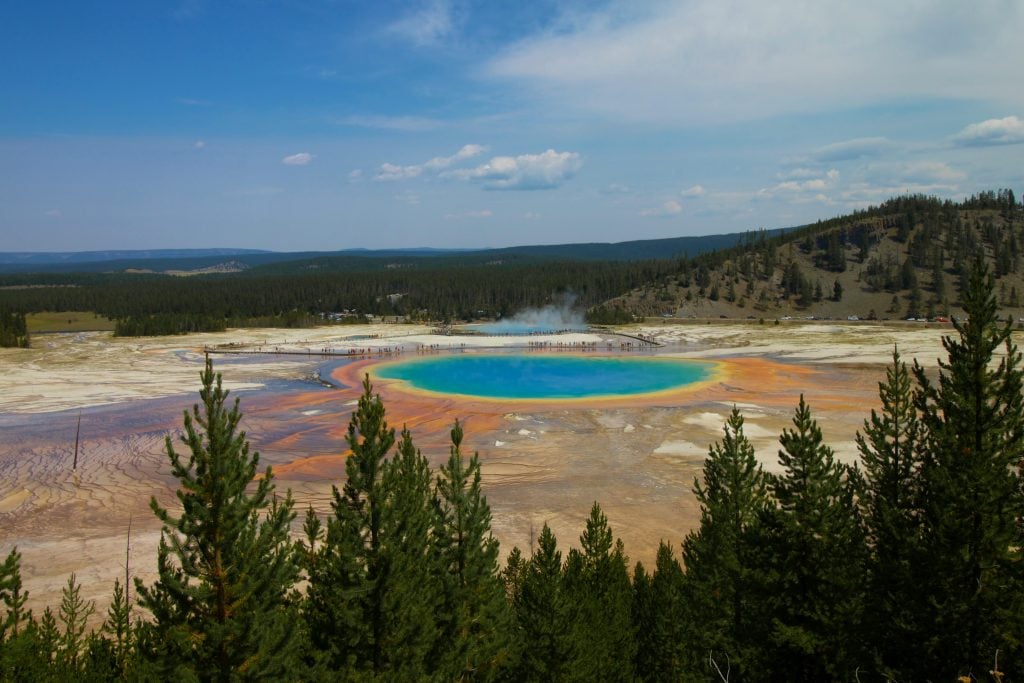
Straddling the intersection of the states of Wyoming, Montana, and Idaho, Yellowstone National Park holds the distinction of being the world’s first national park, established in 1872. Encompassing a vast 8,983 square kilometers (3,472 sq mi), the park is a unique natural wonderland that showcases geothermal marvels, diverse wildlife, and breathtaking scenery.
The park is home to the largest concentration of geysers in the world. The world-famous Old Faithful geyser erupts a 40-meter column of water every 80 minutes. Yellowstone also features other geothermal wonders, including colorful hot springs, mudpots, and fumaroles.
A diverse range of flora and fauna can be found within the park, including 67 mammal species, 324 bird species, 8 fish species, and 311 insect species. Visitors can spot bison, elk, wolves, bears, and lynx among other wild animals roaming the park.
Yellowstone National Park is an ideal destination for those seeking to immerse themselves in the beauty of nature and explore the wonders of geothermal phenomena. The park is open year-round, offering different wonders with each changing season.
Things to Consider Before Visiting Yellowstone National Park:
- There is a park entrance fee.
- Food and water are limited in the park, so it is advisable to bring your own.
- Be cautious of wildlife, such as bears, wolves, and bison.
- Follow park rules and regulations.
I hope this paragraph provides a general overview of Yellowstone National Park. For more information, please visit the park’s official website at https://www.nps.gov/yell/index.htm.
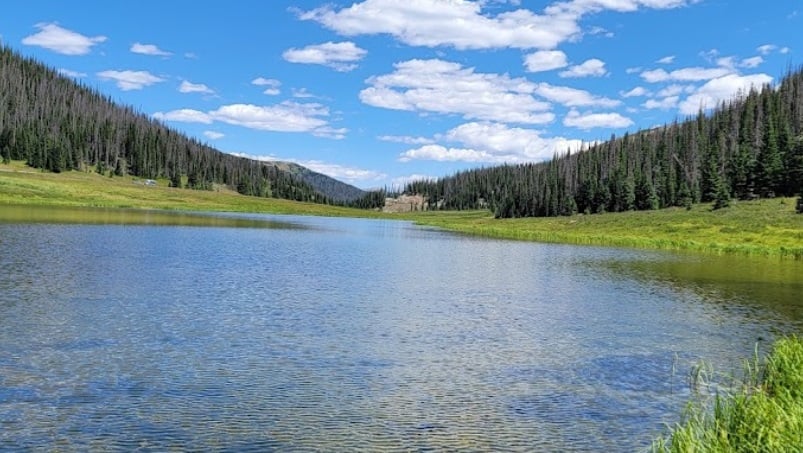
Nestled in the northwestern corner of the state of Colorado, Rocky Mountain National Park is a haven of breathtaking scenery and diverse wildlife, encompassing an area of 1,077 square kilometers (416 sq mi) since its establishment in 1915. The park is home to some of the Rocky Mountains’ highest peaks, crystal-clear lakes, verdant valleys, and alpine meadows.
Visitors can indulge in a variety of outdoor activities in Rocky Mountain National Park, including hiking, camping, fishing, canoeing, and rock climbing. The park also offers lodging options, including historic hotels and chalets.
What Makes Rocky Mountain National Park Special?
-
Breathtaking Scenery: The park boasts iconic peaks like Longs Peak, Estes Peak, and Trail Ridge. From these summits, you can relish panoramic vistas of the majestic mountains, along with forests, valleys, and lakes.
-
Abundant Wildlife: The park is home to a diverse range of wildlife, including elk, deer, bison, sheep, bears, and lynx. With a bit of luck, you might spot these magnificent creatures roaming their natural habitat.
-
Varied Activities: The park caters to visitors of all ages and skill levels, offering a diverse range of outdoor activities. Whether you’re an experienced hiker or a beginner, you’re sure to find something enjoyable in Rocky Mountain National Park.
-
Historic Sites: The park encompasses numerous historic sites, including historic hotels, chalets, and visitor centers. Delve into the region’s rich past by exploring these historic gems.
Things to Consider Before Visiting Rocky Mountain National Park:
- The park is open year-round; however, some roads and facilities may be closed during the winter months.
- There is a park entrance fee.
- It is advisable to bring your own food and water as options are limited in the park.
- Exercise caution around wildlife, such as bears, wolves, and bison.
- Adhere to park rules and regulations.
Rocky Mountain National Park stands as an unforgettable destination for those seeking to immerse themselves in nature’s splendor and experience the thrill of wildlife encounters. The park unveils a different facet of its beauty with each changing season and offers diverse activities suitable for people of all ages and skill levels.
I hope this article provided a general overview of Rocky Mountain National Park. For more information, please visit the park’s official website at https://www.nps.gov/ROMO.
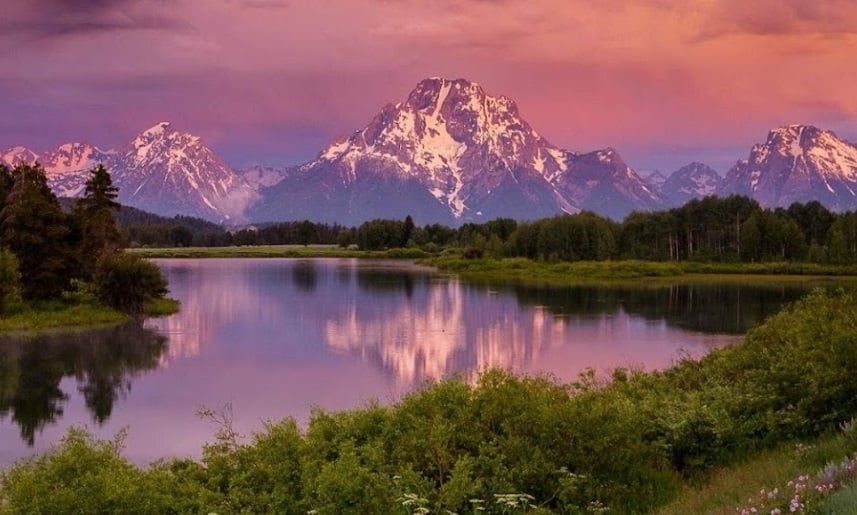
Nestled in the northwestern corner of the state of Wyoming, Grand Teton National Park is a haven of breathtaking scenery and diverse wildlife, encompassing an area of 1,259 square kilometers (486 sq mi) since its establishment in 1929. The park is home to the awe-inspiring peaks of the Teton Range, crystal-clear lakes, verdant valleys, and alpine meadows.
Visitors can indulge in a variety of outdoor activities in Grand Teton National Park, including hiking, camping, fishing, canoeing, and rock climbing. The park also offers lodging options, including historic hotels and chalets.
What Makes Grand Teton National Park Special?
-
Majestic Peaks: The park boasts iconic peaks like Grand Teton, The Cathedral Group, and Jackson Hole. From these summits, you can relish panoramic vistas of the majestic mountains, along with forests, valleys, and lakes.
-
Abundant Wildlife: The park is home to a diverse range of wildlife, including elk, deer, bison, sheep, bears, and lynx. With a bit of luck, you might spot these magnificent creatures roaming their natural habitat.
-
Varied Activities: The park caters to visitors of all ages and skill levels, offering a diverse range of outdoor activities. Whether you’re an experienced hiker or a beginner, you’re sure to find something enjoyable in Grand Teton National Park.
-
Historic Sites: The park encompasses numerous historic sites, including historic hotels, chalets, and visitor centers. Delve into the region’s rich past by exploring these historic gems.
Things to Consider Before Visiting Grand Teton National Park:
- The park is open year-round; however, some roads and facilities may be closed during the winter months.
- There is a park entrance fee.
- It is advisable to bring your own food and water as options are limited in the park.
- Exercise caution around wildlife, such as bears, wolves, and bison.
- Adhere to park rules and regulations.
Grand Teton National Park stands as an unforgettable destination for those seeking to immerse themselves in nature’s splendor and experience the thrill of wildlife encounters. The park unveils a different facet of its beauty with each changing season and offers diverse activities suitable for people of all ages and skill levels.
I hope this article provided a general overview of Grand Teton National Park. For more information, please visit the park’s official website at https://www.nps.gov/grandteton.
What kind of activities can be done in the Rocky Mountains?
The Rocky Mountains are a haven for nature lovers, offering a variety of activities. Hiking, camping, skiing, fishing, canoeing, rafting, biking, and rock climbing are just a few of the many outdoor activities that can be enjoyed.
What are some interesting facts about the Rocky Mountains?
- The Rocky Mountains are home to over 300 glaciers.
- There are over 100 alpine lakes in the region.
- More than 1,000 bird species live in the Rocky Mountains.
- The oldest rocks in the area are 3 billion years old.
- The Rocky Mountains are a UNESCO World Heritage Site.
When is the best time to visit the Rocky Mountains?
The best time to visit the Rocky Mountains is during the summer months (June-August) when the weather is mild. However, if you’re looking for winter sports, the ski season runs from December to March.
How should I plan a trip to the “The Rocky Mountains: The Backbone of North America”?
Before heading to the Rocky Mountains, it’s important to determine what kind of experience you’re looking for. Do you want to go hiking and camping, or are you interested in winter sports like skiing and snowboarding? Once you’ve established your plan, you can pack appropriate clothing and gear for the season you’ll be visiting. There are numerous hotels, motels, and campgrounds in the region for lodging. Renting a car or joining guided tours are also options.

